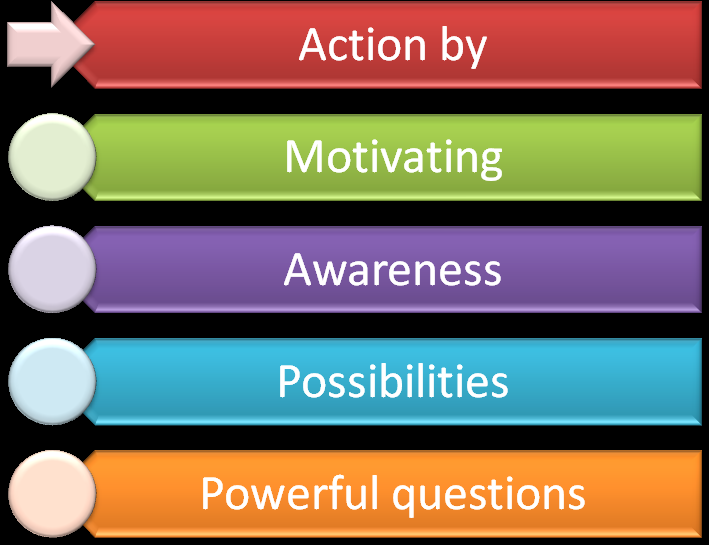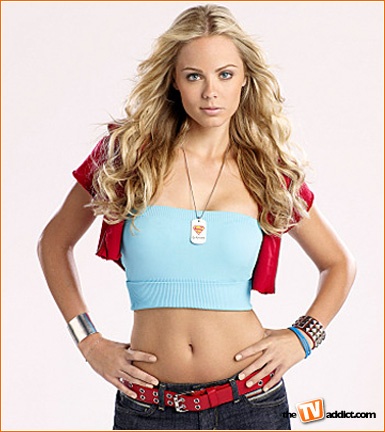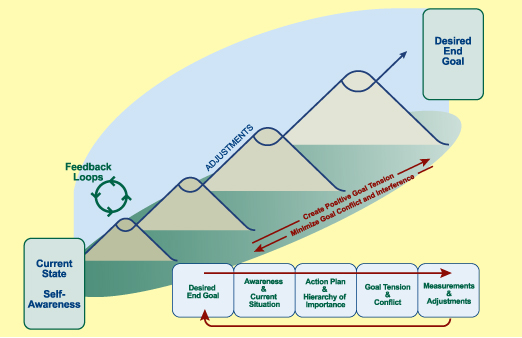274
Executives have strong challenges to meet. To develop themselves, they have to get a clear awareness of their values, strengths and weaknesses, as well as life goals. Without this vision, the efficiency of the coaching process is compromised. It will act like a placebo and will not last long.
This, however, is not sufficient. Executives also need to understand the values and aims of the organisation. They must be sure they suit them. This will allow them to be in a position to understand the requirements, and even to challenge them to excel.
Appropriating the reality of the organisation will empower executives. Then, they will be able to move forward in the coaching process and reach a “shared” goal. The definition of the steps to reach the goal will be facilitated and even more efficient.
Thanks to a better awareness of their strengths, executives will have the opportunity to explore other additional personal developments which may lead them to surpass their goals.
THE COACHING PHASES
Phase I:
Supporting the coachees to clarify who they are, in order to set their development process on a strong and solid basis Two periods:
First period
Clarification of personal values
Clarification of personal life goals
275
Second period
Awareness of “ who I am” - my strengths and weaknesses How people perceive me
My behaviour,
My way of communicating …
…
Clarifying how I perceive the others and why.
This first phase is critical. The coachees need to be completely and deeply aware of their own realities. The deeper the mastery of their internal and outside realities is, bigger will be their capability of personal development. Enhancing their strengths, will be most powerful during this step.
It will also be an opportunity for them to understand how the coaching process can support them, and to build up a secure environment with the coach.
This phase is very powerful and it requires a strong commitment from the coachees. It must be clearly explained at the early stage of the coaching process.
Phase II:
Understanding the organisation, the achievement of the goals sets by the organisation or the person and defining the path to reach the goal.
This second phase will emphasis on:
First Period
Working on the values of the organisation, its goals and vision Understanding the goal sets by the organisation, the coachees Working on how this development will sustain the organisation objectives and the coachees’ objectives.
Empowering to reach the goal
276
Second Period
Defining the path and the steps to reach the goal Discovering and analysing why the coachees could surpass those objectives and how
Phase III: Toward the goal.
This phase will be focusing on supporting the coachees in moving forward to reach their goals. It will be done using the coachees’ daily life so they can practice themselves, gain awareness of their behaviour, and feel the reward and efficiency of their development and progress.
The coaching will focus on establishing long term goals meanwhile ensuring quick wins so the coachees feel supported and empowered. It will help them to demonstrate how they have changed to the people and get positive feedbacks.
The coachees will be supported in discovering what additional competencies or knowledge they could reinforce to feel more comfortable when reaching their goals and even surpassing them.
The coaching process during this phase will work on anchoring the new habits and enjoying the comfort and the empowerment they provide.
Lasting improvement comes from obtaining—and acting on—honest feedback about performance. By assessing their progress, the coachees will be able to build on it and improve even more!
Development is a self-reinforcing, self-perpetuating habit that continues to serve you long after the formal coaching engagement is over.
Source:
http://www.fpcoachingtolead.com/how%20is%20it%20working
%202.html
277

2.31 aMAP2TM COACHING MODEL
Developed by Devers and Kulesa.
Action by:
Motivating
Awareness and Possibilities using Powerful questions
The “aMAP2™” approach is implementation focused in asking both the coach and the person being coached to consider change issues.
278
Some Powerful Questions
1. Is that true?
2. How do you know that?
3. What data is that claim based on?
4. What do others say that support your/my argument?
5. What evidence would you give to someone who doubted your interpretation?
6. Can you put that another way?
7. What’s a good example of what you are talking about?
8. What do you mean by that?
9. Can you explain the term you just used?
10. How do you think the other person views the situation?
11. You have only two years to live and will do so with your usual energy and vitality. What will you do with your last two years?
12. What are you not telling me that I need to know?
13. You just won a $100 million lottery jackpot. What will you do with the rest of your life
14. What is your life like 1 year from now?
15. Describe the context of your situation
16. What is keeping you busy these days
17. What is keeping you up at night?
18. When was the last time you lost track of time? what were you doing at that time?
19. What are you doing now to shape your life of tomorrow?
20. What can you stop doing to make room for change?
21. What are you holding on to that no longer serves you?
22. What assumptions are you making in this situation?
23. What do you want? what do you need?
24. Is there an easier way?
25. What is within your power to change?
26. What do you want the outcome to be in this situation?
27. What needs to change?
279

28. Am I judging based on my own values or theirs?
29. What is the point of view of the person sitting across the table?
30. Is what I’m about to say helping to achieve our/me goal?
Does it add value?
Source:
List by Linda De luca
http://azione-scopo.com/2010/11/11/30-powerful-questions/
280

2.32 RESULTSTM COACHING
The Results Coaching model is a cutting edge approach to coaching developed by David Rock in 1996 (Source: http://www.resultslifecoaching.com.au/find/david_rock.html) R Reflect -Take time to think, ask questions and re-frame E Evaluate -Carefully assess all the forward options S Strategise -Select the plan(s) with the best chance of succeeding
U Understand -Appreciate what resources will be needed to succeed,
L Listen -Pay attention to the input of employees and colleagues
T Take Action -Implement plans and follow-though persistently
S Systematise -Ensure that processes are permanently changed
281
2.33 STRIDE COACHING
This model has been developed by Will Thomas, author of two very useful books: Coaching Solutions: Practical Ways to Improve Performance in Education and Coaching Solutions: Resource Book .
• Strengths: Affirm the positive throughout and draw attention to their strengths.
• Target: What do you want to achieve as a result of this process?
• Reality: What is the current situation like now and what obstacles are there to achieving your goals?
• Ideas: What could you do to address the situation?
• Decision: What are you going to do? What are the next steps?
• Evaluation: Check the decision: How committed are you to doing this? - Over time: What progress have you made towards meeting these targets?
The essential aspect of the STRIDE model is that it really celebrates the strengths of the coachee so the whole process becomes a very positive experience.
However, it does encourage the coachee to consider what obstacles there may be, which could prevent them from reaching their target, but they also have to consider how they could overcome these obstacles. The job of the coach is to keep asking open-ended questions to help the coachee to move towards a solution.
282
2.34 FLOW COACHING
The FLOW model is explained in Powell et al. (2001).
• Find the challenge: What is the issue that you need to address?
• Look at reality: What are things like now?
• Open possibilities: What could you do about it?
• Win commitment: What are you going to do and when?
There are clear similarities between the STRIDE and FLOW
models. One of the key differences is that the STRIDE model starts by looking at the coachee’s preferred future, whereas the FLOW model starts by talking about the challenge, that is, What is it that you want to address? From this starting point will then come the discussion about what the targets are.
Both models emphasise the need to look at what the reality is now. This is important, as it will open up a dialogue about what the obstacles or blocks are which are stopping the coachee from making progress. Only once these are brought to the fore can the issue really start to be addressed. It is surprising how often this is the key part of a coaching session and that by just seeing thesituation clearly (rather than what was thought or imagined to be the situation), the resolution often becomes obvious and straightforward.
Lastly, the STRIDE model encourages the coachee to evaluate both the appropriateness of the target and the progress towards it over time.
283
2.35 THE HILDA COACHING MODEL
One of the best bits of advice regarding coaching was also one of the simplest. It followed a discussion with a colleague about the importance of not getting too hung up on following a script when it comes to coaching. We felt that it should be a natural and flowing dialogue between two professionals and the coach should not have to constantly refer to a bank of questions, whilst engaged in coaching. This is most off-putting for the coachee and does not help to create the informal and relaxed atmosphere required for coaching. With this in mind, it was suggested that the best type of person to become a coach is a nosey person! Someone who will quite naturally ask question after question in order to find out what they want – and in doing so, will also help the coachee to find out. This simplicity seemed most appealing.
Some readers might remember a character called Hilda Ogden –
the archetypal nosey neighbour – in Coronation Street (a long-running television soap, based in the north of England). What a fantastic coach she could have made, with her continuous probing and incisive questioning. This led us to consider an alternative, simple model for coaching – the HILDA model.
• Highlight the issue:
What do the coachees want to address?
What do they want to be different and how?
• Identify the strengths:
What do they already do well?
How can these skills and attributes be used to address the particular issues?
284
• Look at the possibilities:
In an ideal world, with no obstacles, what could they do to address the issues?
What is getting in the way of doing this?
How could these obstacles be overcome?
What have they already tried? - What worked and what didn’t?
• Decide and commit to action:
What are they going to do to address the issues?
When are they going to do it? How are they going to do it?
• Analyse and evaluate the impact:
How will they know if they have been successful?
What will it look like?
Although in its early days, we have used this model in schools with an encouraging degree of success. Its simplicity makes the key stages easy to remember, within the framework of a constant reminder to ask open questions throughout each of the stages.
Source: The Coaching Toolkit: A Practical Guide for Your School By Shaun Allison, Michael Harbour
285
2.36 THE FORREST COACHING PATH
The Forrest Coaching Path™ is a series of signposts to guide the coaching engagement. The Path is the culmination of extensive research and over 20 years of effectiveness coaching.
Visualize the End Goal
The End Goal is the future, enhanced state of effectiveness to which the organization and the coachee aspire as a function of both organizational strategy and personal development. End Goals are as diverse as organizations and coachees, but can include increased effectiveness in specific or general work capacity, future status or position, or communication and interpersonal abilities.
After the End Goal has been identified, attention turns to the Current State. It is important that the End Goal be identified prior to the Current State; otherwise, the coachee’s aspirations may be artificially constrained.
Identify the Current State
The Current State reflects the self-awareness of the coachee. It is directly linked to the End Goal because if there is too large a gap between the two, the resulting tension can either compromise the reach of the goal or make it unattainable. The Current State examination will require honesty and forthrightness on the part of the coach and the coachee.
No coaching session can keep the two elements of End Goal and Current State separate – it is a continuously iterative process.
However, the coach needs to always bear in mind the natural tendency for a coachee to overly dwell on and react to the Current State. This can distort the coachee’s natural energy – it may seem overwhelmingly difficult to escape their current 286
reality or, from the opposite side, the coachee may be overly eager to escape the world in which they live.
Develop an Action Plan
The most important part of the coach’s role is to help the coachee develop a plan to achieve their goals from their current position. The coaching relationship thus far is focused on questioning but, by the third signpost, the coachee will likely be looking for advice. Developing and following a detailed plan will help the coachee handle the tensions on the way to achieving the goal. However, the coach needs to beware of putting too much emphasis on a plan and, in some cases, it may be necessary to allow the coachee to let matters unfold rather than follow a script.
Manage Goal Tension and Minimize Conflict
As the coachee works toward the goal, the role of the coach is to anticipate where the coachee may have difficulties and where the tensions of reaching goals may be too difficult to overcome.
Here is where the coach really demonstrates their value. The coach needs to be able to anticipate tensions, be available to assist the coachee as these tensions grow, and aid the coachee in minimizing these tensions in order to allow the coachee’s creative abilities to work unencumbered. In many cases, the coachee will have to adjust his or her plans and the coach will need to be able to provide suggestions. Forrest coaches anticipate these issues and, by being proactive, can profoundly help their coachees.
Measurements and Adjustments
Ongoing through the engagement is the necessity to set measurements and make adjustments. Measurements will be as complex or specific as the engagement requires, and may be as simple as checking-in after every session to see how, and how much, they valued the session. The more mature coaching 287

relationships will likely be able to set measures upfront.
Coaches must avoid the implicit tension of these benchmarks, either avoiding them or racing toward them. Measurements enliven the coachee and allow them to see true progress being made. The other half of setting measures is to allow for adjustment to plans. When the circumstances surrounding a goal fundamentally change, the measures attached to that goal must also change. These changes are realistic and will naturally fall from discussions with the coachee.
Source: The Forrest Coaching Path™
Michael Clark - Director, Sales & Marketing - 416.925.2967 x262
Copyright © 2012 Forrest & Company Limited.
288
2.37 FIVE-STEP COACHING MODEL
2.37.1 The Five-Step Coaching Model
The Five-Step Coaching is a scientifically-based yet simple approach, that can serve as the backbone of any coaching engagement:
1. Define.
Identify coaching goals.
2. Assess.
Obtain relevant data and baseline performance data.
3. Plan.
Develop an action plan to achieve the stated goals. Include quantifiable success metrics.
4. Act.
Execute the plan.
5. Review.
Evaluate the results. Did the program achieve its goals?
2.37.2 The Five-Step Coaching Model For Responding to Bullying at School
Once bullying has been reported, both the student who was bullied and the student who bullied must receive coaching. It is essential that there be no exceptions to this rule. We recommend that specific staff members be prepared to coach students. Often, these are administrators or coachs. The following sections give details about the models staff should use when coaching students.
Always coach the student who was bullied and the student(s) who bullied separately. The power differential inherent in bullying makes it difficult for targeted students to ask adults for 289
help in the first place. A forced meeting with the student who bullied can be an overwhelming experience for a targeted student. Also, a targeted student may deny that there is a problem if questioned in the presence of a bullying student.
Coaching the student who was bullied
For many reasons, students rarely report the bullying they experience to adults. They may be afraid of retaliation, they may think the bullying is their fault, they may feel ashamed, or they may believe that adults are unable or unlikely to stop the harassment. Combat students’ feelings of helplessness and reluctance to report by following a five-step process.
Step 1:
Affirm the student’s feelings.
Say: “You were right to report/get help from an adult.” Step 2:
Ask questions.
Get information about the current situation and the history of the situation.
Step 3:
Identify what has and has not worked in the past.
Step 4:
Generate solutions for the future.
• Discuss how the student can avoid the person who has bullied him or her. (Examples: The student could take a new route to classes, sit closer to the bus driver, or stay close to a friend or group of friends.)
• Create a plan with the student.
• Coach the student in using assertiveness skills. (If relevant to the situation, remind the student that aggression is never an appropriate solution.)
290
• Identify others (parents, teachers, friends) who can support the student.
Step 5:
Follow up.
• See how the plan is working.
• Contact parents as appropriate.
• Inform the student’s teachers.
Coaching the student who bullied
Students commonly experiment with bullying and domineering behaviors in middle school. Teach them positive behaviors by coaching them through alternative actions. Particularly with initial bullying, withhold judgments of blame and focus instead on helping students adopt positive behaviors that avoid “even the appearance of bullying.” Your school’s bullying policy should provide the necessary framework for a multilevel approach that clearly outlines appropriate consequences for initial and repeated bullying.
In addition to consequences, students who continue to bully may need more targeted help addressing their problem behavior. Students are more likely to change problem behavior if adults help them select positive alternative behaviors and provide consistent feedback about their progress.
Source:
Second Step: Student Success Through Prevention © 2008
Committee for Children
291
This coaching model (for use with students who bully) has five steps:
Step 1:
Identify the problem and diffuse reporting responsibility.
• “I have been hearing that...”
• “Many students have reported that...”
Step 2:
Ask questions and gather information.
• “I’d like to hear from you about what happened.”
• “How would you feel if this happened to you?” Step 3:
Apply consequences.
• Discuss the school bullying policy.
• Enforce the agreed-on discipline.
Step 4:
Generate solutions for the future.
• Create a plan with the student.
• “What are some ways to prevent this from happening again?” Step 5:
Follow up.
• See how the plan is working.
• Contact family members or the student’s teachers
• Refer the student for further discipline as appropriate.
292
2.37.3 The Five-Step Coaching Model
This model has been refined after years of research and modeling of what makes successful people tick, and what makes teams work together productively. As well as being derived from experience, it also draws on the best ideas that leading experts recommend.
The 5 steps are Outcome, Flexibility, Feedback, Support and Challenge.
Outcome
Ideas don’t just happen. It may feel like they do, but in reality they are created; and so the fundamental thing for any team to get right is the correct definition of precisely what it is that they want to achieve. Stating the intention positively, in such a way that it can almost be felt, stimulates everyone to explore every avenue that is available in order to turn things into reality. Also identifying potential obstacles, both physical and emotional, will greatly increase the chances of success. You’ll learn how state your intentions in a precise, motivating way, so that the whole team can sense the success. Getting this right is the foundation of successful teamworking.
Flexibility
If you always do what you’ve always done, then you’ll always get what you’ve always got. Creative teams need to work together to identify a greatly expanded set of possibilities to experiment with, and the flexibility element introduces tools, techniques and attitudes that create more choice. Having more options means more chance of success.
Feedback
Every action generates a result. It might not be exactly what the team intended, and all too often we slip into immediate judgement mode when faced with a ‘wrong’ result, which can 293
prevent further action. However, it is still a result, and with the right attitude the team can use it to form the basis of learning and change. The way that we interpret our results and hence learn from feedback is crucial in determining whether the team is paralysed by failure or they learn and move on.
Support
In order to get the most out of yourself and your team, you need to establish a positive, supportive atmosphere in which people (including you) have the confidence to take bold actions.
Success lies beyond the boundaries of current experience and only people who have the courage to step beyond their current limits and thinking will achieve something new. In order to do that, you need to create a supportive team atmosphere in which people are free to experiment, and in this module you’ll understand the principles that great motivators use to get the best out of people.
Challenge
Creative teamworkers can increase their effectiveness by paying careful attention to their interactions with others. This helps them to explore the thinking of others and hence get the best out of any situation. Words, language, actions, intentions and behaviours are all crucial in maximising team effectiveness and creativity. In the Challenge element you will learn the linguistic skills that you will need to get the best out of your interactions with others.
Source:
COPYRIGHT © COACHING IDEAS - ALL











